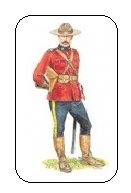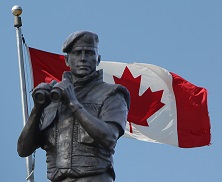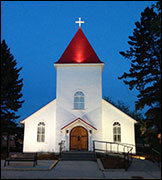True and Fascinating Canadian History

Vet of the Month: July 2009
Reg.#32, Sergeant James Colvin. NWMP
Great Grandson
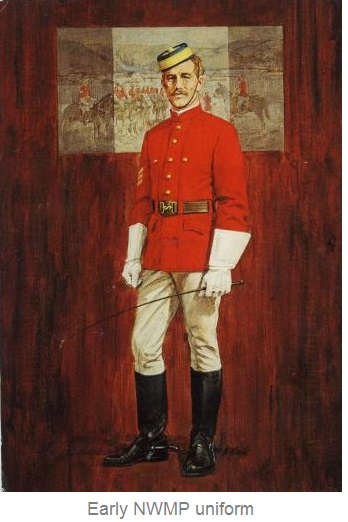
James Colvin arrived in Canada at the Port of Quebec (Quebec City) on September 29, 1870. He had left Glasgow, Scotland on September 14, aboard the Allen Line Steamship SS Corinthian one of 108 passengers on that voyage. The record of his arrival is contained in a Ship's Passenger List held by the National Archives Of Canada and is shown on Microfilm Roll C-4526, Manifest No. 112 where he is listed as Jas. Colvin, age 24, single, nationality Scotch and gave his occupation as a Clerk.
As mentioned in his obituary, between the time James Colvin arrived in Canada in 1870 and 1875 when he joined the NWMP he apparently worked as a conductor on the Grand Trunk Railway in Ontario.
Records obtained from the National Archives of Canada, File RG 18G, Volume 3318, describe the North West Mounted Police (NWMP) service record of James Colvin, Regimental No. 32, New Series.
On May 29, 1875, James Colvin signed an Engagement Document with the NWMP for a service period of three years. On June 3, 1875 he swore an Oath of Allegiance to the Crown and an Oath of Office before G.W. Griffiths, Justice of the Peace for the Northwest Territories. The location where he took and signed these oaths was described as "On Board, Manitoba."
The original NWMP force had travelled overland from Manitoba to Fort Macleod the previous year (1874) following a route through the southern prairies. Since this proved to be a very arduous journey, in the following years, until the railroad was completed to Calgary in 1883 all NWMP personnel, supplies and mail were sent by stern wheel steam boats up the Missouri River in the USA to Fort Benton, Montana.
They then travelled overland from Fort Benton to Fort Macleod, a distance of some 200 miles, by oxen drawn wagon trains and horseback. It is assumed that this would have been the route that James Colvin travelled on his way to Fort Macleod in 1875. This route was also known as the Whoop Up Trail, named after a Fort located near Lethbridge.
In the fall of 1875, James Colvin along with the other members of F Troop under the command of Captain Brisbois were sent from Fort Macleod to the confluence of the Bow and Elbow Rivers where they established Fort Calgary.
On May 3, 1878, James Colvin signed up for another three years of service with the NWMP at Fort Macleod, NWT. Having completed three years of service entitled James Colvin to a bounty land warrant for 160 acres of land and on June 20, 1878 a certificate for same was issued by the Department of the Secretary of State. The certificate is No. 0148. On October 3, 1878 James Colvin sold his 160 acre land warrant to George Wonnacott for $60. George Wonnacott was a fellow officer in the NWMP stationed at Fort Walsh.
On April 5, 1880 James Colvin requested an early discharge from the NWMP in order to take the position of Indian Agent at Fort Walsh. He was stationed at Fort Walsh at that time and had been there since 1877. This request was granted, and his discharge certificate was filled out and signed by James Macleod, Commissioner of the NWMP who described Colvin's "conduct during Service as very good." At the time of his discharge, James Colvin held the rank of Staff Sergeant.
A marriage record, Registration No. 1883-06-001068, obtained in October, 2004 from the Vital Statistics Agency of the Province of Manitoba shows that James Colvin and Matilda Fisk were married in Winnipeg on February 12, 1883. This record also confirms his birthplace as Aberdeen, Scotland and that of his wife Matilda as Guelph, Ontario. At the time that James Colvin applied for the marriage licence he reported his occupation as an accountant with the Canadian Pacific Railway.
Obituary: Mr. Calvin.
Calgary Herald, June 1885
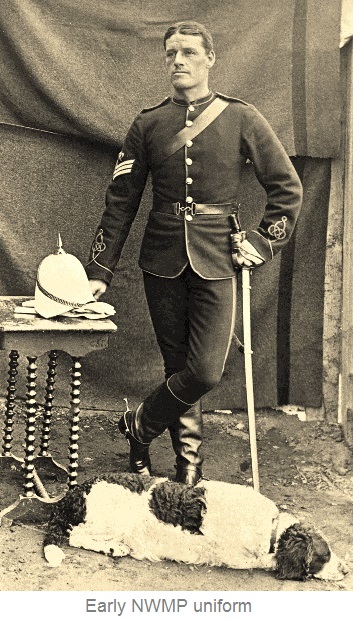
"It is with the sincerest regret that we have to record in the events of the week that has passed, the death of James Colvin, book-keeper for G.C. King & Co., which occurred in Calgary on Monday morning last. Mr. Colvin's many friends both here and at Macleod, and throughout the whole district, will not be surprised at the announcement, as his health has been known to be failing for some weeks, but few of them expected it so soon.
The death of a man, of whom it can be said that he had no enemies and all who knew him respected and loved him, is regrettable enough, but when he is in the prime of life, happily placed and happily married, in view of a competency for the rest of his days, and beginning to reap the fruits of many years hard work, it is especially to be regretted.
Mr. Colvin came to the Northwest from Toronto to join the Mounted Police in 1875. No one ever heard him speak of his people who are believed to live in the old country, but when in Ontario he was a conductor on the G.T.R. When he joined the force in 1875 G.C. King, Joe Butlin and James Carroll, all well known in Calgary, were in the force. Mr. Colvin was stationed first at Macleod, but when Fort Calgary was built in September of that year, he was stationed with Mr. King and Capt. Brisbois at this point.
In the Spring of 1876 he was made a corporal by Capt. Crozier and Asst. Commissioner Irvine. In the early part of 1877, during the war with the American Sioux he accompanied the force to Cyprus. Capt. Crozier always thought a great deal of him as did every officer in the force with whom he came in contact, and it was due to Crozier that he was presently appointed staff sergeant(sic); a position he held till 1881 when he left the Force.
While at Cyprus, Mr. Colvin had been appointed acting Indian agent, and after leaving the police he remained in that position. In 1882 he gave up the position to take that of supply officer to the C.P.R. construction under Engineer Perry. In 1883 the department was removed to Calgary to the site of the present Colvin homestead. When the railway passed Calgary, and the Perry department was broken up, he took a position as book-keeper and confidential clerk to Mr. King, which position he remained in to his death. In the same year, 1883, he married, his wife and one child surviving him.
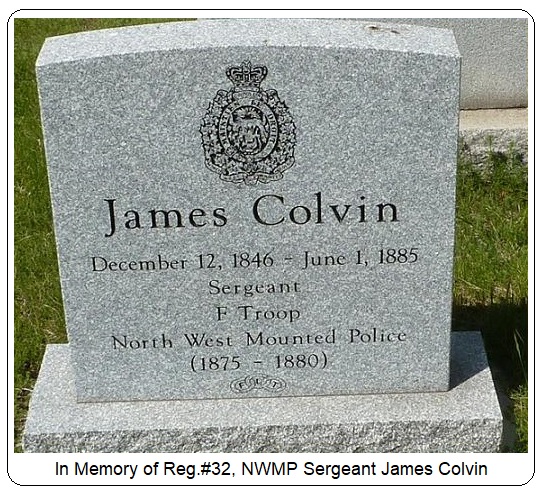
Last March he began to complain of ill health and two doctors pronounced it an affliction of the heart. It was not till three weeks ago that he made up his mind to go east for a change and went as far as Winnipeg. While there he consulted Dr. Jones, but nothing could be done for him, and he finally made up his mind to return home. On Sunday last he arrived by train in a dying condition and was immediately taken home by members of the Odd fellows order to which he belonged.
A few hours later he died." RIP
RIP
The Oddfellows took the arrangements for the funeral in their own hands and at their suggestion he was given a temporary resting place in a corner of Geo. Hamilton's homestead until a public cemetery has been secured by the town. He was buried on Tuesday, Mr. Dyke reading the service in the presence of a large number of friends.
He was only 38 years old at the time of his death, 10 of those years having been passed in this country, and a better, more kindly fellow and faithful friend would be hard to find."
G. G. King. Geo. Murdoch
Calgary, June 4th, 1885
As noted in the above obituary, James Colvin's remains were interred on the homestead of George Hamilton. When a municipal cemetery was established in the Shaganappi area of Calgary later in 1885, his remains were moved to that location. The Shaganappi area proved to be an unsuitable location for a cemetery and all interments at that location were moved to Union Cemetery.
Cemetery records show his grave is located in Section B, Block 6, Lot 39. Section B of Union Cemetery contains the graves of a number of the early NWMP members including those of Commissioner James Macleod and George C. King who was in the NWMP at the same time as James Colvin. George King wrote the above obituary for James Colvin and later served a term as Mayor of Calgary.
On June 23, 2000 a ceremony was held in Union Cemetery and a gravestone marking the previously unmarked grave of James Colvin was unveiled by his great grandson James R. Morrison and Alan Muise-Benner. Alan is a descendant of the Fiske family, Mitilda Fiske was James Colvin's wife. The event was coordinated by the Fort Calgary Historic Park Society to celebrate the 125th anniversary of the founding of Fort Calgary in 1875.
His gravestone is engraved as follows:
December 12, 1846 - June 1, 1885
Sergeant
F Troop
North West Mounted Police
(1875 - 1880)
*A member of F Troop, the NWMP,
founders of Fort Calgary
*Indian Agent at Cypress Hills (Fort Walsh) until 1882
*Veteran of the Grand Trunk and Canadian Pacific Railways, who helped to see the rails through Calgary
*First I.O.O.F. burial in Alberta
*Civic promoter
There are four photographs in the Glenbow Archives in Calgary, Alberta that show James Colvin in group pictures of NWMP personnel stationed at Fort Walsh.
The above biographical material is also on file at the same location and was placed there by (me) -- his great grandson.
James R Morrison,
March, 2001
My very sincere appreciation goes to Mr. James Morrison for keeping in contact with me during his research of NWMP Reg.#32, James Colvin and for providing us with great insight into one of the earliest members of the Force.
Reporting from Fort Healy,
J. J. Healy
July 23, 2009
